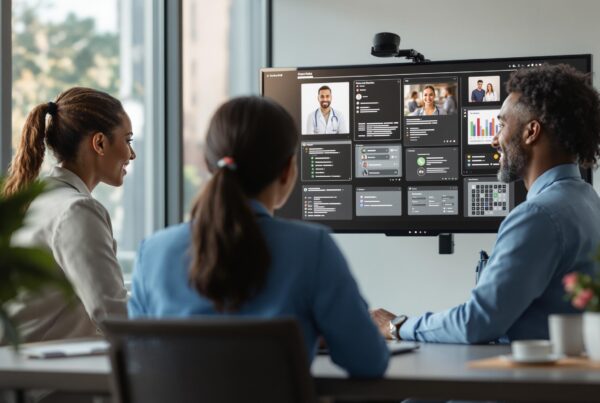Ever tried to solve a puzzle with missing pieces? That’s how it feels when you’re running a healthcare operation without a remote medical assistant. Their role in modern healthcare is like that elusive piece, completing the picture. This post reveals the benefits and challenges in your communication strategy with remote medical office assistants. From improving patient care to ensuring your practice runs smoothly, a remote assistant can cost-effectively support many aspects of a medical practice.
Table of Contents:
- Importance of Communication and Building Strong Relationships with Remote Medical Office Staff
- The Role and Benefits of Remote Medical Assistants
- Effective Communication Strategies for Remote Medical Assistants
- Building Strong Relationships with Remote Medical Assistants
- Maintaining Open Channels of Communication with Remote Medical Assistants
- Fostering a Sense of Team Unity with Remote Medical Assistants
- Overcoming Challenges in Communicating with Remote Medical Assistants
- FAQs in Relation to Communicating With Remote Medical Assistants
Importance of Communication and Building Strong Relationships with Remote Medical Office Staff
As the healthcare industry evolves, communicating with remote medical assistants has become crucial. The significance lies in their role; they handle key administrative tasks like scheduling appointments, managing complaints, organizing phone questions, and handling billing.
The rise of virtual health care has led to an increase in remote medical assistant job opportunities. Remote working, however, brings its own set of difficulties. One such challenge is maintaining strong relationships within the team. This is where effective communication plays a pivotal role.
Fostering Team Unity among Remote Medical Assistants
In any work environment, unity promotes productivity and satisfaction among team members. For remote teams especially, it’s vital to foster this sense of belongingness for smoother operations.
A successful way to build this bond? Regular check-ins. Make sure you’re not just asking about their workload but also how they are doing personally. It can be as simple as starting your weekly meetings by sharing one good thing that happened over the weekend.
Maintaining Open Channels Of Communication With Your Virtual Team
An open channel ensures everyone feels heard which helps boost morale and efficiency within your team. This doesn’t mean micromanaging though.
Rather than hovering over every task they do or flooding them with constant messages throughout the day (which could actually decrease productivity), focus on being accessible when help is needed while respecting boundaries during off-hours. This balance between availability and respect for personal time contributes to a healthy work-life balance for your remote medical assistants.
Understanding the Importance of Strong Relationships
A solid relationship with your team members leads to trust, and trust breeds efficiency. Remote workers who feel valued are more likely to stay loyal and motivated in their roles, which is particularly important given the industry-wide staffing shortage.
The key here is empathy. Comprehending that remote employees have individual lives away from their jobs can be a major factor in forming enduring connections.
Key Takeaway:
Building strong relationships with remote medical assistants is key for smooth healthcare operations. Regular check-ins and open communication channels boost team unity and morale, without resorting to micromanaging. Understanding their personal lives outside of work can help foster empathy, loyalty, and efficiency within the team.
The Role and Benefits of Remote Medical Assistants
Remote medical assistants are changing the game in healthcare. They play a vital role by offering remote support to doctors, nurses, and other healthcare professionals. From handling patient inquiries to managing schedules, they’re like the superheroes behind the scenes.
Who Hires Medical Assistants Working from Home?
Diverse organizations employ these multitasking marvels. These range from private practices to large-scale hospitals, insurance companies, and even health-tech startups. As per Indeed, job opportunities abound for virtual medical assistants with a passion for promoting healthy outcomes.
In addition to traditional care settings, telemedicine platforms also hire medical assistants working remotely. They recognize their value in providing seamless patient care while improving operational efficiency.
Skills Required for a Work-from-Home Medical Assistant
Becoming an effective work-from-home assistant isn’t just about clinical tasks or knowing your way around electronic health records. It’s much more than that.
You’ll need to be adept at both verbal and written communication since you will regularly interact with patients and colleagues. Familiarity with medical terminology is key too; it’s kind of like learning another language.
A knack for administrative duties can help as well since organizing appointments or dealing with insurance verification will be part of your day-to-day activities.
Now, let’s talk money. The average salary for remote medical assistants is around $37,190 per year or between $16 to $25 per hour. So if you’re looking to pursue opportunities that give you work-life balance while making a difference in healthcare – this could be your gig.
Key Takeaway:
Remote medical assistants, the silent warriors of healthcare, offer vital help to professionals right from their homes. They’re jacks-of-all-trades with top-notch communication skills and a solid grasp on medical lingo. Plus, if they’ve got an aptitude for admin tasks – even better. Though certification can boost your chances, don’t forget this job isn’t just about the paycheck. It’s also about fostering healthier lives and striking that perfect work-life harmony.
Effective Communication Strategies for Remote Medical Assistants
Navigating the world of remote healthcare requires a strong set of communication skills. This is particularly true for virtual medical assistants who are tasked with both clinical and administrative duties, all while working from home.
Patient care can be complex even in an office setting, but it’s a whole different ball game when done remotely. A patient’s wellbeing may hinge on your ability to convey information clearly and accurately. For example, explaining test results or providing instructions about medication usage demands precision.
The Role of Technology
Digital tools play a crucial role here. They not only facilitate conversations between healthcare teams and patients but also ensure smooth coordination among team members scattered across various locations.
A few helpful tools include video conferencing platforms like Zoom for real-time discussions or project management apps such as Trello to keep track of tasks at hand. Digital solutions have been key in meeting staffing crisis needs, proving their indispensability.
Maintaining Patient Confidentiality
In addition to making sure messages get across correctly, you must uphold the highest standards regarding patient confidentiality. Breaches can lead not just to loss of trust but legal consequences too.
Cultural Sensitivity: The Unsaid Rule
Besides understanding technical jargon and maintaining privacy rules, cultural sensitivity plays an integral part in effective communication strategies. Remote job opportunities often span diverse cultures, requiring adaptability and respect towards varying perspectives that come into play.
Building Strong Relationships with Remote Medical Assistants
Working remotely can sometimes feel isolating, but building strong relationships with remote medical assistants is key to fostering team unity and improving patient care. This process starts by understanding their role.
A remote medical assistant, for example, typically handles administrative tasks like scheduling appointments or handling billing issues. It’s a job that requires excellent communication skills and an ability to work independently.
Retaining Remote Medical Assistants
Maintaining a strong relationship isn’t just about making sure your virtual medical assistants are happy – it’s also crucial for retention. In fact, one way to retain these valuable team members is by recognizing their hard work and providing opportunities for professional growth.
In our current healthcare landscape where staffing shortages are common, keeping talented professionals on your remote team is vital. As mentioned in this insightful article from ScienceDirect, promoting healthy work-life balance among healthcare providers has been linked directly to higher staff retention rates.
This may include strategies such as creating a supportive culture where everyone feels valued and respected. Offering incentives or acknowledgments can help demonstrate gratitude for the efforts of these specialists on a daily basis.
The bottom line? Building solid relationships with remote medical assistants isn’t only beneficial—it’s essential. Remember: behind every successful healthcare provider there’s likely an army of dedicated virtual assistants working tirelessly to ensure smooth operations.
By recognizing their value, you can create a remote work environment that’s not just productive, but also harmonious and fulfilling for all team members. Achieving a harmonious and productive work environment should be the ultimate goal.
Maintaining Open Channels of Communication with Remote Medical Assistants
When working with remote medical assistants, it’s crucial to keep the lines of communication wide open. This helps ensure efficient operations and smooth delivery of healthcare services.
The Importance of Open Communication
An open channel fosters transparency and builds trust among team members. Having the capacity to give prompt criticism is critical in a quickly developing industry like healthcare where choices frequently must be made rapidly. But how do you maintain this openness when your team is dispersed?
One effective way is by using digital tools designed for real-time collaboration and communication such as Slack, Microsoft Teams or Google Meet. These platforms allow teams to stay connected regardless of their physical location, promoting seamless coordination between onsite staff and remote medical assistants.
Promoting Regular Interaction
Besides professional exchanges, encouraging casual interactions can also contribute positively towards building rapport among virtual teams. Virtual coffee breaks or social hours provide opportunities for bonding that might otherwise be missed in a work-from-home setting.
In addition, providing clear guidelines on communication protocols helps everyone know what’s expected from them regarding response times or availability during non-working hours. Remember: clarity reduces misunderstandings.
Acknowledging Contributions & Feedback
Last but not least, recognizing the contributions made by remote medical assistants goes a long way toward fostering an environment conducive to open communication – everybody loves being appreciated. Don’t forget about soliciting their input too; they may have unique insights into improving processes because they’re interacting directly with patients remotely.
Retaining Your Valuable Assets
- Fostering a supportive work culture.
- Offering recognition and rewards for good performance.
- Providing opportunities for professional growth.
Not only do these steps boost job happiness, they also soften the blow of the widespread staff shortage by keeping your talented virtual medical assistants on board. After all, as this HT World report confirms, digital solutions really can make a difference.
Key Takeaway:
Keep communication lines wide open with your remote medical assistants to boost efficiency and trust. Use digital tools like Slack or Google Meet for real-time collaboration, encourage casual interactions, and provide clear guidelines on response times. Recognize their contributions and ask for their feedback as they may have unique insights into improving processes.
Fostering a Sense of Team Unity with Remote Medical Assistants
Creating team unity among remote medical assistants is like knitting. You need the right tools, patience, and consistency to weave a cohesive pattern.
The Role of Technology in Fostering Team Unity
Technology acts as our virtual knitting needle. It helps us bring together individual threads (team members) into a unified fabric (the team). With platforms that meet the digital needs of today’s healthcare landscape, we can keep everyone connected no matter where they are.
We use tech not just for daily tasks but also for bonding activities. Virtual coffee breaks or online games sessions aren’t just fun—they’re vital signs indicating our team health.
Just like in-person teams, remote medical assistants must feel part of something bigger than their individual roles. They should know they contribute meaningfully to patient care even if they work miles away from other team members or patients themselves.
This sense of belonging comes when communication channels are always open and collaboration is encouraged across time zones. Every question asked by an assistant could lead to better patient service; every idea shared might improve administrative processes more efficiently than before.
Promoting Healthy Work-Life Balance Among Remote Medical Assistants
Beyond professional interactions though lies another crucial factor—promoting healthy work-life balance among your remote workforce—a key ingredient in fostering unity. When people know their well-being matters at work too, it fuels motivation and fosters loyalty towards the organization itself. Let’s not forget: Happy employees often translate into happy patients.
Creating a unified team can be tricky when everyone’s remote—no casual chats or shared lunches. But, with some imagination, determination and smart use of tech, we can still build strong bonds.
Key Takeaway:
Creating a tight-knit team with remote medical assistants is all about mixing the right tech, clear chat, and promoting work-life harmony. Use digital tools for jobs and fun activities alike. Spark teamwork across different time zones – each question or idea might enhance patient service or streamline workflows. Don’t forget, pushing for wellness fuels drive and loyalty: often when employees are happier,
Overcoming Challenges in Communicating with Remote Medical Assistants
Working with remote medical assistants can sometimes bring unique challenges, especially when it comes to communication. One such challenge is navigating time zone differences.
Navigating Time Zone Differences
Patient scheduling and improving patient care are paramount for a smoothly running healthcare system. However different time zones can pose an obstacle to this seamless operation.
To overcome this, you need an understanding of the work schedules across different geographical locations. Use digital tools that allow setting reminders or alarms according to various time zones. This way, everyone knows when they should be available for meetings or consultations.
Remember that maintaining effective communication isn’t just about managing logistics; it’s also about creating rapport and mutual respect among team members. Acknowledging their effort goes a long way toward building strong relationships and promoting a healthy work environment.
Apart from this hurdle, there might be other roadblocks like language barriers or technological issues that could hamper efficient interaction between healthcare providers and their virtual teams.
Certainly, not all interactions will go perfectly every single day – but remember that even face-to-face communications have their own set of challenges. So don’t let minor hiccups discourage you from harnessing the benefits of hiring remote medical assistants.
“Communications difficulties were seen as inevitable… The real problem was not so much inadequate transmission facilities but people who failed to use them properly.”
FAQs in Relation to Communicating With Remote Medical Assistants
How should you communicate as a medical assistant?
Be clear, concise, and respectful. Listen carefully to patients’ needs or concerns, respond promptly, and maintain confidentiality at all times.
What is a barrier to communication for a medical assistant?
A common hurdle can be jargon or complex medical terms. It’s crucial to explain things in layman’s terms so patients understand their care plans.
Who must medical assistants be able to communicate with?
Medical assistants need solid communication skills with everyone: doctors, nurses, other staff members, and especially the patients they serve.
What role should a medical assistant take on concerning communications when working with patients?
Their role includes relaying information between doctors and patients accurately while showing empathy during patient interactions.
Conclusion
Their roles span from improving patient care to ensuring smooth practice operations.
The benefits are clear: they bring unique skills and offer flexible solutions in the face of healthcare challenges. Building strong relationships and maintaining open communication channels with these professionals can elevate your team’s performance significantly.
Remember this, though: navigating through time zone differences or technological barriers might seem daunting initially. But remember, every challenge presents an opportunity for growth!
In summary, communicating with remote medical assistants is no longer just an option; it’s a strategic necessity in our modern world of healthcare. Harness their potential wisely to transform your practice into a beacon of efficient and effective patient care.
Ready to Learn More?
Schedule some time to learn how we can help your medical practice become more streamlined and free up your time to serve more patients.



